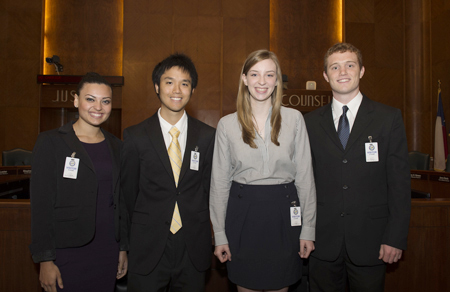MEDIA CONTACTS:
David Ruth
713-348-6327
david@rice.edu
Jade Boyd
713-348-6778
jadeboyd@rice.edu
Rice math students: Helping Houston save dogs
Houston officials praise student study of ‘no-kill’ feasibility for city dog shelter
HOUSTON — (May 6, 2013) — City officials in Houston are praising the work of a team of Rice University undergraduates who spent the past nine months creating a Web application that predicts how proposed policies and initiatives will impact the live-release rate at the city’s municipal dog shelter.
The students — graduating seniors Lilibeth Mata, Katherine McConachie, James Rigby and Bryan Wigianto — presented their results April 29 to the Houston City Council’s Committee on Quality of Life. Council members and officials from the city’s Bureau of Animal Regulation and Care (BARC) praised the students’ work at the hearing. They said the team’s Web application, which serves as a dog-shelter simulator, will help city officials evaluate proposed programs that BARC could use in its quest to become the nation’s largest “no-kill” municipal dog shelter.
The students, who call their team “Kennel Club,” conducted the research throughout their senior year as part of their capstone engineering design course in Rice’s Department of Computational and Applied Mathematics.
“We were tasked with investigating the feasibility of implementing a ‘no-kill’ policy for the city of Houston,” Mata said.
BARC takes in about 16,000 stray dogs each year. Over the past decade, BARC’s live-release rate for stray dogs has climbed from less than 10 percent to more than 50 percent. In its investigation, Kennel Club created a tool to compare BARC with Austin’s municipal dog shelter, which takes in about 11,000 dogs per year and has a live-release rate greater than 90 percent — the industry standard for “no-kill” classification.
“We were fortunate to get lot of data from both BARC and the shelter in Austin, and that helped us create a realistic mathematical model for our simulator,” Rigby said. “The simulator is a tool that people can use to figure out what direction you need to take the shelter to get the desired results as far as your live-release rate is concerned. Essentially, what you can do is fiddle around with main parameters like the intake rate or average health of the dogs coming in or the number of cages in the shelter, and you can see how those changes affect the live-release rate.”

Rice University graduating seniors (from left) Lilibeth Mata, Bryan Wigianto, Katherine McConachie and James Rigby spent nine months creating a Web application that predicts how proposed policies and initiatives will impact the live-release rate at Houston's municipal dog shelter.
In presenting the simulator to the council committee, Wigianto explained three ways that dogs can leave the shelter and avoid being euthanized: return home to their owners, get adopted by a new owner or be transferred to another facility like a nonprofit shelter.
“We learned early on that the probability of transitioning from one place to another on the chart depended heavily upon the condition of the dog,” Wigianto said. So the team created a model that accounted for health differences of incoming dogs as well as things like variability in the number of dogs entering the shelter during different seasons or on certain days of the week.
“Our simulation basically ‘learns’ from the data that we got from BARC, and it accurately captures the behavior of the shelter, and more importantly, it predicts the consequences of different parameter choices,” Wigianto said.
He said the team’s research found that the city will likely need to invest more money if it wishes for BARC to achieve the no-kill threshold of 90 percent live releases.
“With BARC’s current resources, no-kill seems infeasible,” he concluded in his presentation at City Hall April 29. “There are ways to increase the live-release rate, and BARC can look into the cost of each of these strategies and use our model to estimate the optimal allocation of resources to increase the live-release rates most efficiently.
Wigianto also said the team’s findings suggested that any “seriously effective strategy” for achieving no-kill status must focus on reducing the volume of dogs coming into BARC.
“Other strategies, such as increasing the transfer network or the number of cages, will help, but unfortunately, these strategies only treat the symptoms of a bigger problem,” he said.
City spokesman Chris Newport said city officials had previously looked for rigorous academic tools and resources to evaluate policy choices at BARC, but very little was found.
“There’s just not much there,” said Newport, the council liaison and public information officer for Houston’s Department of Administration and Regulatory Affairs. “What these students are doing is really leading-edge stuff, not just in Texas or in Houston, but probably in the nation. It’s going to be really valuable for us as a policy tool.”
The members of Kennel Club are slated to graduate May 11, and each has a job offer or has been accepted to graduate school. They say the experience of working on a real-world problem their senior year was memorable, and they hope their work will have a long-lasting and positive impact in Houston.
“On first glance, applied mathematics and animal shelters might not seem to go together, but math can be applied to any problem,” McConachie said. “In this case, where the debate tends to be driven by emotion and love of animals, quantitative analysis can really help by providing solid numbers and helping people work toward next steps.”
###
VIDEO is available at:
http://youtu.be/JeMzRNhwbVc
High-resolution IMAGES are available for download at:
https://news2.rice.edu/files/2013/05/0430-KENNEL-group082-lg.jpg
CAPTION: Rice University graduating seniors (from left) Lilibeth Mata, Bryan Wigianto, Katherine McConachie and James Rigby spent nine months creating a Web application that predicts how proposed policies and initiatives will impact the live-release rate at Houston’s municipal dog shelter.
CREDIT: Jeff Fitlow/Rice University

